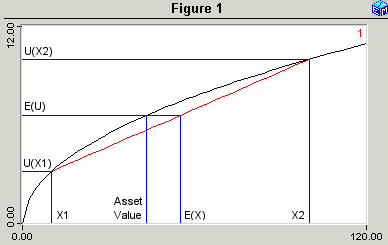The most direct way to place an economic value on a risky asset is to observe the value of that asset in the financial markets, attributing the difference between the observed price and the price that might prevail without risk to the value of the risk.
Economics also studies the theory of risk valuation for agents with curved utility functions. The theory shows that, if an agent's utility function features diminishing marginal utility of money, then that agent will be risk averse. We can quantify the degree of that risk aversion for particular risky assets.
![]() Model Link: Utility-Based Valuation of Risk
Model Link: Utility-Based Valuation of Risk
<activate
the model links>
Printable PDF Exercises
 This
EconModel application studies a simple numerical example that captures the
flavor of the theory. An agent contemplates an asset with two possible
values, X1 and X2. The probabilities of these values are 1-P and P.
This
EconModel application studies a simple numerical example that captures the
flavor of the theory. An agent contemplates an asset with two possible
values, X1 and X2. The probabilities of these values are 1-P and P.
To develop an intuitive understanding of this theory, the EconModel application lets the user change X1, X2, and P and redraw the diagram. These steps will show how the value of the risk depends on the spread between the good and bad outcomes and the probabilities of those outcomes.
Classic Economic Models
Macroeconomics
Introduction
Overview of Macro Models
Models in Chronological Order
The Classical Model
The Simple Keynesian Model
The Keynesian IS/LM Model
The Mundell-Fleming Model
Real Business Cycles
The IS/MP Model
The Solow Growth Model
Financial Markets
Utility-Based Valuation of Risk
Mean-Variance Analysis:
Risk vs. Expected Return
Fixed Income Securities:
Mortgage/Bond Calculator
Growth Investments:
Present Value Calculator
Microeconomics
Introduction
Overview of Micro Models
Supply and Demand
Basic Supply and Demand
Who Pays a Sales Tax?
The Cobweb Model and
Inventory-Based Pricing
Theory of the Firm
Perfect Competition
Monopoly and
Monopolistic Competition
Price Discrimination
The Demand for Labor
Theory of the Consumer
Two Goods - Two Prices
Intertemporal Substitution
Labor Supply, Income Taxes,
and Transfer Payments
Resources